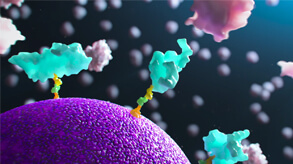The future of NASH & NAFLD research is non-invasive
The SomaSignal® NASH tests:
4 key indicators, 1 liquid biopsy
Protein scanning is the only technology capable of predicting all 4 NASH components simultaneously and non-invasively.
- Measures steatosis, inflammation, fibrosis, and ballooning
- Corresponds with staging as measured by liver biopsy
- Reveals drug-mediated improvements in disease severity
- Provides insight into treatment mechanism of action
Non-invasive testing enables frequent sampling.
- Does not require specialized physicians/pathologists
- Simple blood draw is ideal for longitudinal studies
- Removes the subjectivity of pathologist scoring
Curated NASH research publications
Additional resources
WebinarDetect biomarkers associated with nonalcoholic fatty liver disease (NAFLD)
In this 1-hour discussion, learn how the SomaScan assay can be used to detect biomarkers associated with NAFLD—specifically, the identification of circulating proteins associated with fibrosis in NAFLD using a custom 5k-plex SomaScan assay. Also discussed is the importance of identifying non-invasive biomarkers that improve clinical decision-making and drug development for NAFLD, and the strategies for multiplexed validation of candidate biomarkers discovered using the SomaScan assay.WebinarCorrelation of a nonalcoholic steatohepatitis proteomic test with clinical outcomes
In this webinar, Anne Minnich, PhD, biomarker consultant at Bristol Myers Squibb, presents research on the use of the new SomaSignal(TM) NASH bundle test in a recently completed clinical trial.WebinarThe liquid liver biopsy: characterizing NASH and NAFLD with serum protein biomarkers
With SomaScan® Proteomics, predicting NASH and NAFLD is as simple as a blood test. Nonalcoholic fatty liver disease (NAFLD) and nonalcoholic steatohepatitis (NASH) are increasingly common conditions that can progress to serious liver complications including cirrhosis and cancer. Diagnosing the severity of NAFLD and NASH has traditionally relied on invasive liver biopsies. It was recently demonstrated that the SomaScan Assay, a multiplex proteomics platform, can noninvasively and simultaneously predict all the key elements of the liver biopsy: liver fat, inflammation, hepatocyte ballooning and fibrosis based only on serum protein biomarkers. By measuring ~5000 proteins per sample in ~700 patients, with liver biopsy results, machine learning models were developed and validated that can reliably predict NAFLD/NASH phenotypes . The tests were used to characterize the differential mechanistic effects of three different drugs during clinical trials. In this webinar, Dr. Steve Williams, the Chief Medical Officer for SomaLogic, will present this work and introduce a soon to be launched NASH test that is available for research use only through the SomaScan Discovery Alliance.White paperSerum protein signatures as a non-invasive tool for monitoring nonalcoholic steatohepatitis
NASH and NAFLD are characterized by distinct sets of protein signatures. In our latest white paper, we discuss how researchers have used the SomaScan® Assay to characterize and predict NASH non-invasively, even beating the best available clinical model. Download the white paper to learn more about how to get the most out of your NASH and NAFLD clinical samples with the world’s most impactful protein assay.PosterLiquid liver biopsy
A liquid liver biopsy: serum protein patterns of liver steatosis, inflammation, hepatocyte ballooning and fibrosis in NAFLD and NASH.The SomaSignal NASH tests are built on a dataset of ~3 million protein measurements
Nonalcoholic fatty liver disease (NAFLD) is characterized by accumulation of fat in the liver and impacts as much as 1/3 of the US population.
30% of patients with NAFLD develop nonalcoholic steatohepatitis (NASH), which can include fibrosis and signals risk for the development of cirrhosis and liver cancer. Diagnosing the severity of NAFLD and NASH has traditionally relied on invasive liver biopsies and histological examination by a highly trained Hepatologist.
It was recently demonstrated that NASH and NAFLD can be characterized non-invasively using proteomics.
By measuring ~5,000 proteins in each of ~700 patients and comparing the results with liver biopsies, researchers developed machine learning models that can simultaneously detect all the key elements of a liver biopsy—steatosis, hepatocyte ballooning, lobular inflammation, and fibrosis—non-invasively, using just serum proteins. These models were subsequently used to characterize mechanisms of action for three different drugs in clinical trials.
A non-invasive, proteomics-based test for steatosis, ballooning, inflammation, and fibrosis is now available for research use only via the SomaSignal NASH tests.
The SomaSignal NASH tests use a binary scoring system to characterize samples as positive or negative for the four different indicators independent of diabetes status or presence/absence of therapeutic intervention. The SomaSignal NASH tests are available on their own or in conjunction with the full menu of 7,000 protein measurements derived from the SomaScan Assay.
Additional SomaSignal tests
The CVD, heart failure, and cardiorespiratory fitness tests make up a subset of 22 SomaSignal tests available for research use. Any or all of the SomaSignal tests are available for a single flat cost.
Contact one of our experts today
The statements herein have not been evaluated by the Food and Drug Administration




